
HMS Endeavour was a British Royal Navy research vessel that Lieutenant James Cook commanded to Australia and New Zealand on his first voyage of discovery from 1768 to 1771.

Invincible was originally a 74-gun ship of the line of the French Navy launched in October 1744. Captured on 14 May 1747, she was taken into Royal Navy service as the third rate HMS Invincible. She was wrecked in 1758 after hitting a sandbank. The wreck is a Protected Wreck managed by Historic England.

Admiral Mariot Arbuthnot was a British admiral, who commanded the Royal Navy's North American station during the American War for Independence.
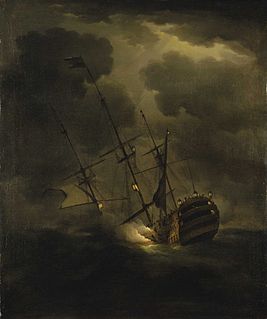
HMS Victory was a 100-gun first-rate ship of the line of the Royal Navy, built to the dimensions of the 1733 proposals of the 1719 Establishment at Portsmouth Dockyard, and launched on 23 February 1737/8.

HMS Liverpool was a 28-gun Coventry-class sixth-rate frigate of the Royal Navy. Launched in 1758, she saw active service in the Seven Years' War and the American Revolutionary War. She was wrecked in Jamaica Bay, near New York, in 1778.
Five Royal Navy ships have had the name of HMS Culloden, after the battle of Culloden which took place in Scotland in 1746 and saw the defeat of the Jacobite rising.

Association was a 90-gun second-rate ship of the line of the Royal Navy, launched at Portsmouth Dockyard in 1697. She served with distinction at the capture of Gibraltar, and was lost in 1707 by grounding on the Isles of Scilly in the greatest maritime disaster of the age. The wreck is a Protected Wreck managed by Historic England.
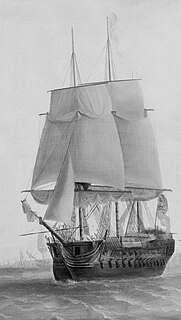
Courageux was a 74-gun ship of the line of the French Navy, launched in 1753. She was captured by the Royal Navy in 1761 and taken into service as HMS Courageux. In 1778 she joined the Channel Fleet, and she was later part of the squadron commanded by Commodore Charles Fielding that controversially captured a Dutch convoy on 31 December 1779, in what became known as the Affair of Fielding and Bylandt. On 4 January 1781, Courageux recaptured Minerva in a close-range action west of Ushant that lasted more than an hour. That April, Courageux joined the convoy under George Darby which successfully relieved the Great Siege of Gibraltar.
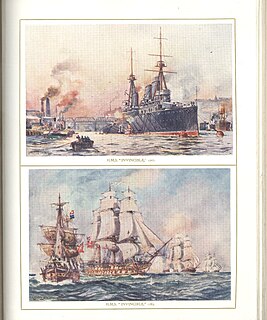
HMS Invincible was a 74-gun third-rate ship of the line of the Royal Navy, launched on 9 March 1765 at Deptford. Invincible was built during a period of peace to replace ships worn out in the recently concluded Seven Years' War. The ship went on to serve in the American War of Independence. May, 1778 under command of Capt. Anthony Parry. Fought at the battles of Cape St Vincent in 1780, and under the command of Captain Charles Saxton, the Battles of the Chesapeake in 1781 and St Kitts in 1782.
HMS Nymph was a 14-gun Swan-class sloop of the Royal Navy, built by Israel Pownoll and launched at Chatham Dockyard on 27 May 1778. She was accidentally burnt and sank in the British Virgin Islands in 1783.

Culloden Point is a small peninsula north of Montauk, New York, that marks the east entrance to Fort Pond Bay from Gardiners Bay.
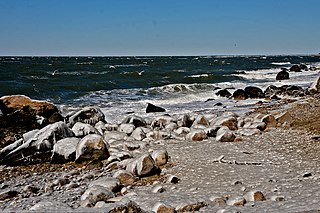
Fort Pond Bay is a bay off Long Island Sound at Montauk, New York that was site of the first port on the end of Long Island. The bay has a long naval and civilian history.

Copper sheathing is the practice of protecting the under-water hull of a ship or boat from the corrosive effects of salt water and biofouling through the use of copper plates affixed to the outside of the hull. It was pioneered and developed by the Royal Navy during the 18th century. In antiquity, ancient Greeks used lead plates to protect the underwater hull.

The Culloden-class ships of the line were a class of eight 74-gun third rates, designed for the Royal Navy by Sir Thomas Slade. The Cullodens were the last class of 74s which Slade designed before his death in 1771.

HMS Alarm was a 32-gun fifth-rate Niger-class frigate of the Royal Navy, and was the first Royal Navy ship to bear this name. She was built at King's Yard in Harwich by John Barnard.
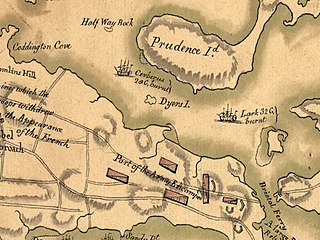
The Wreck Sites of HMS Cerberus and HMS Lark are located in the waters of Narragansett Bay on the west side of Aquidneck Island near South Portsmouth, Rhode Island.

The Rhode Island State Navy was the first colonial or state navy established after the American Revolutionary War began in April 1775 with the Battles of Lexington and Concord. On the following June 15, the General Assembly authorized the acquisition of two ships for the purpose of defending the colony's trade. The state's ships were generally used for defensive operations within Narragansett Bay, although some prizes were taken. The state was also one of the first to authorize privateering.
At least four ships of the Royal Navy have borne the name HMS Mentor:

HMS Roebuck was a fifth-rate ship of the Royal Navy which served in the American and French Revolutionary Wars. Designed in 1769 by Sir Thomas Slade to operate in the shallower waters of North America, she joined Lord Howe's squadron towards the end of 1775 and took part in operations against New York the following year. She engaged the American gun batteries at Red Hook during the Battle of Long Island in August 1776, and forced a passage up the Hudson River in October. On 25 August 1777, Roebuck escorted troopships to Turkey Point, Maryland, where an army was landed for an assault on Philadelphia. She was again called upon to accompany troopships in December 1779, this time for an attack on Charleston. When the ships-of-the-line, which were too large to enter the harbour, were sent back to New York, Admiral Marriot Arbuthnot made Roebuck his flagship. She was, therefore, at the front of the attack, leading the British squadron across the shoal to engage Fort Moultrie and the American ships beyond.




















